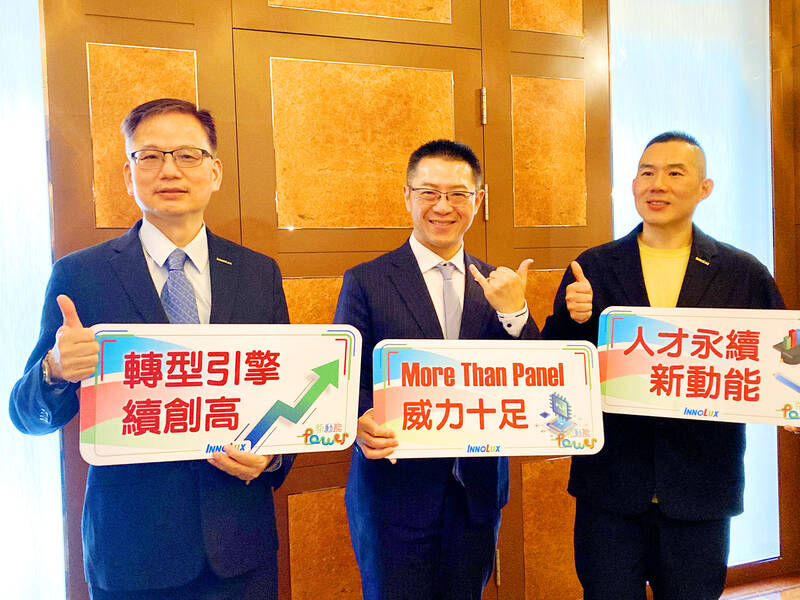Flat-panel display maker Innolux Corp (群創) yesterday said it is stepping up investment on developing panel-level packaging technologies, and that it plans to allocate more than 15 percent of its capital expenditures next year to the new semiconductor business.
This investment demonstrates Innolux’s determination to diversify from a pure flat-panel display manufacturer and to escape from the industry’s boom-and-bust cycles, the Miaoli-based company said.
The chip packaging business would play a vital role in the company’s transformation efforts, it said.

Photo: Lisa Wang, Taipei Times
This year, Innolux planned to spend about 15 percent of its annual capital expenditures, about NT$20 billion (US$612 million) or a little under that amount, on semiconductor-related technologies and equipment. About 85 percent would be allocated for its core display business, it said.
“In the long term, we hope for the semiconductor and display businesses to each account for half of the company’s total expenditures,” Innolux chairman Jim Hung (洪進揚) told reporters during an annual media event in Taipei yesterday.
“We intend to raise the portion of semiconductor investment each year,” Hung said.
Innolux’s entry into the semiconductor packaging sector has caught the attention of investors and semiconductor experts, as advanced packaging technologies are seen as potential solutions to extending Moore’s Law, when scaling technology reaches its physical limits. This is a reference to Intel co-founder Gordon Moore, who observed in 1965 that the number of transistors on an integrated circuit were doubling about every two years with minimal rise in cost.
Innolux’s aim is to create a new value-added business by leveraging its flat-panel display capacity and technologies. The first step is to revitalize a less advanced 3.5-generation flat panel fab and repurpose the glass substrates for chip packaging to create better value, since the fab is not cost-competitive, the company said.
The company originally planned to start shipping the first products using its first-generation panel level package (PLP) technology, called Chip-First technology, by the end of this year, it said, adding that it was targeting mid-to-low-end chips such as power ICs, or radio-frequency ICs, which are mostly used in smartphones and other consumer electronics.
However, a slump in smartphone demand stalled the company’s plan, Hung said.
Now, the company hopes to postpone the shipment until the first half of next year, when smartphone demand picks up a bit, he said.
Despite the setback, Innolux continues investing in second and third-generation PLP technologies, with the aim of progressing to mid-range and advanced chips.
To tap into silicon photonics, a new chip packaging technology, Innolux has acquired unspecified shares of two small-scale companies, BE Epitaxy Semiconductor Technology Co Ltd (元澄半導體科技) and Best Epitaxy Manufacturing Co Ltd (先發光電), it said.
Hung said that he had reached his turn-around goal for the company during his first 6-year tenure.
Innolux reported its second profitable quarter in a row, with profits of NT$421 million last quarter. In the first three quarters of this year, it accumulated losses of NT$2.55 billion, an improvement from losses of NT$15.4 billion during the same period last year.
Local rival AUO Corp (友達) has been in the red for the last 10 quarters. Losses have improved to NT$4.68 billion during the first three quarters, compared with losses of NT$16.69 billion a year ago.

Taiwan Semiconductor Manufacturing Co (TSMC, 台積電) would not produce its most advanced technologies in the US next year, Minister of Economic Affairs J.W. Kuo (郭智輝) said yesterday. Kuo made the comment during an appearance at the legislature, hours after the chipmaker announced that it would invest an additional US$100 billion to expand its manufacturing operations in the US. Asked by Taiwan People’s Party Legislator-at-large Chang Chi-kai (張啟楷) if TSMC would allow its most advanced technologies, the yet-to-be-released 2-nanometer and 1.6-nanometer processes, to go to the US in the near term, Kuo denied it. TSMC recently opened its first US factory, which produces 4-nanometer

GREAT SUCCESS: Republican Senator Todd Young expressed surprise at Trump’s comments and said he expects the administration to keep the program running US lawmakers who helped secure billions of dollars in subsidies for domestic semiconductor manufacturing rejected US President Donald Trump’s call to revoke the 2022 CHIPS and Science Act, signaling that any repeal effort in the US Congress would fall short. US Senate Minority Leader Chuck Schumer, who negotiated the law, on Wednesday said that Trump’s demand would fail, while a top Republican proponent, US Senator Todd Young, expressed surprise at the president’s comments and said he expects the administration to keep the program running. The CHIPS Act is “essential for America leading the world in tech, leading the world in AI [artificial

REACTIONS: While most analysts were positive about TSMC’s investment, one said the US expansion could disrupt the company’s supply-demand balance Taiwan Semiconductor Manufacturing Co’s (TSMC, 台積電) new US$100 billion investment in the US would exert a positive effect on the chipmaker’s revenue in the medium term on the back of booming artificial intelligence (AI) chip demand from US chip designers, an International Data Corp (IDC) analyst said yesterday. “This is good for TSMC in terms of business expansion, as its major clients for advanced chips are US chip designers,” IDC senior semiconductor research manager Galen Zeng (曾冠瑋) said by telephone yesterday. “Besides, those US companies all consider supply chain resilience a business imperative,” Zeng said. That meant local supply would

Servers that might contain artificial intelligence (AI)-powering Nvidia Corp chips shipped from the US to Singapore ended up in Malaysia, but their actual final destination remains a mystery, Singaporean Minister for Home Affairs and Law K Shanmugam said yesterday. The US is cracking down on exports of advanced semiconductors to China, seeking to retain a competitive edge over the technology. However, Bloomberg News reported in late January that US officials were probing whether Chinese AI firm DeepSeek (深度求索) bought advanced Nvidia semiconductors through third parties in Singapore, skirting Washington’s restrictions. Shanmugam said the route of the chips emerged in the course of an